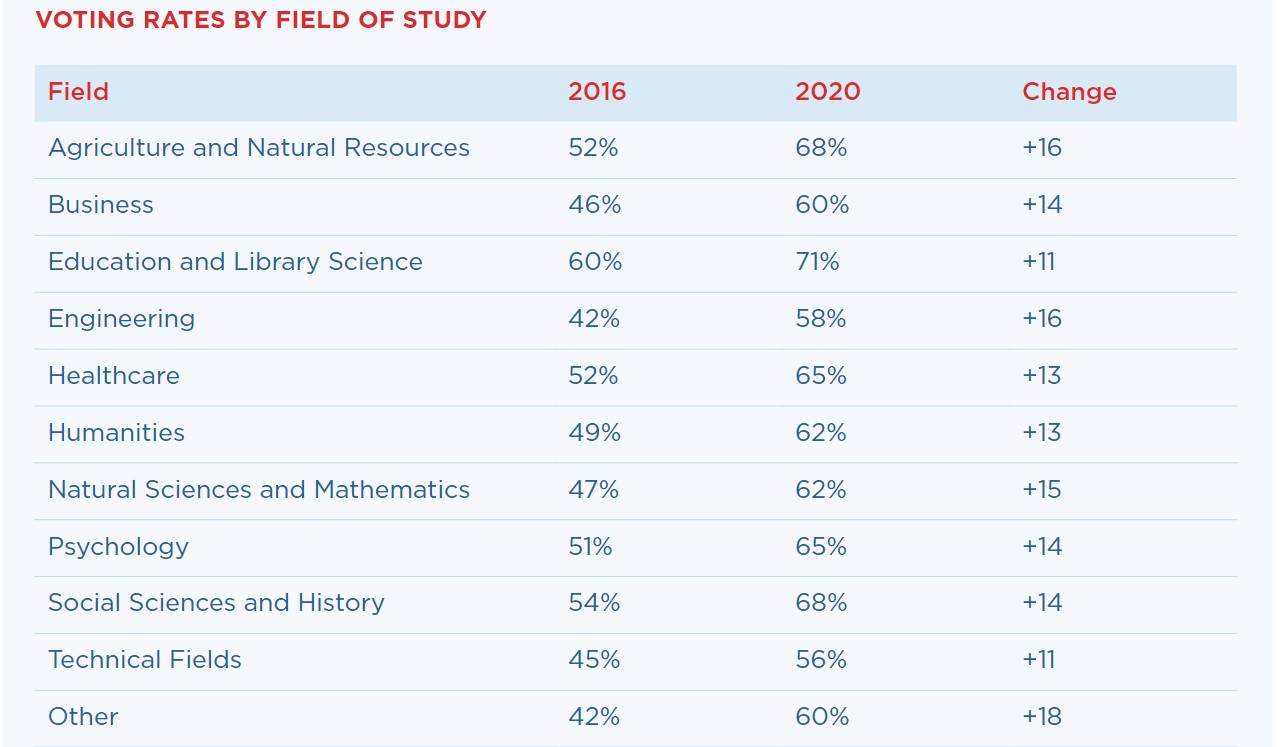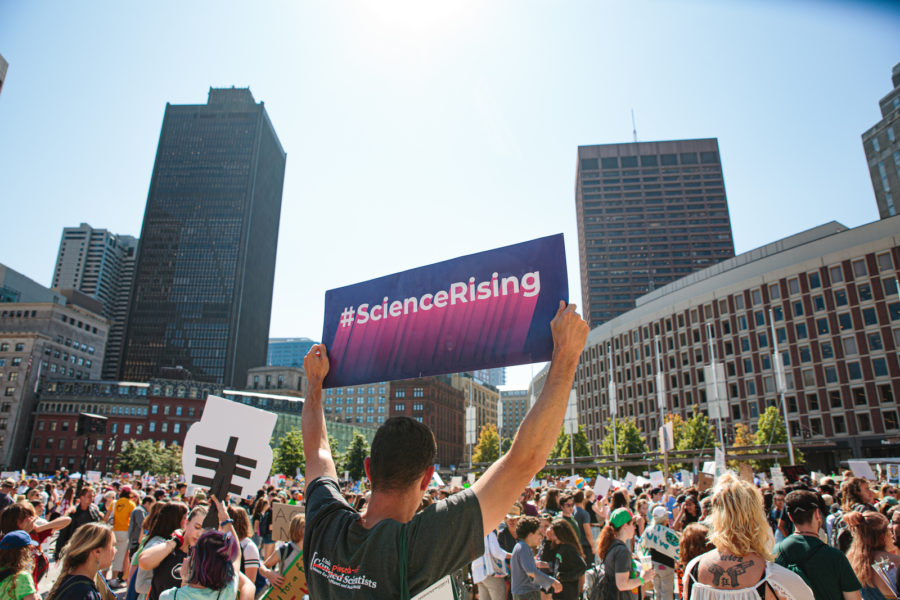The numbers are in from a survey of student voters during the 2020 election, and across the board we saw a significant increase in the number of students in science, technology, engineering, and mathematics (STEM) fields who turned out to vote! It’s among the remarkable results in this new report measuring US student voter turnout, and reflects a dramatic increase in student voting across the board. Overall, the national student voting rate in 2020 increased by 14 percent above 2016 levels, reaching 66% in 2020, up from 52% in 2016.
It’s exciting to see that STEM majors stepped up to vote in 2020, but there are still more opportunities—and more work to be done—to increase turnout even more in the future. Indeed, despite big increases in 2020, the fields of engineering, healthcare, natural sciences and mathematics, psychology and technical fields still voted at lower rates than the average student turnout rate, though they did considerably close the gap from previous years.
Key report takeaways
These numbers come from the Institute for Democracy & Higher Education at Tufts’ Tisch College of Civic Life, which just released the latest National Study of Learning, Voting, and Engagement (NSLVE).
The report breaks down voting rates by field of study (engineering, business, humanities, etc.) and found that STEM-related fields increased their voting rates by double digits. Notably, engineering and agriculture/natural resources increased their turnout by 16 percentage points over 2016; agriculture/natural resources majors reached 68 percent turnout. Natural sciences and mathematics increased their voter turnout rates by 15 percentage points, up to 62 percent. Psychology saw a 14 percentage point increase, bringing them up to a 65 percent turnout rate.

Where does this data come from?
The National Study of Learning, Voting, and Engagement (NSLVE) is a way for colleges and universities to track their student registration and voting rates over time. According to their website, “NSLVE data are the result of matching student enrollment records with public voting files.” They work to protect student privacy during the matching process, while also seeking to provide data that campuses can use to increase voting rates.
This study looks at voting rates from two- and four-year public and private colleges and universities, including graduate programs, who opt in to participate. In 2020, that included 1051 campuses representing over 9 million student voters.
Putting this data into context
The increased voting rates among STEM majors in 2020 were likely due to a combination of factors: key science issues like the pandemic and climate change were priorities for many voters; vote by mail made voting more accessible for some; the election was a key topic of conversation in the national media for months, and many other contributing factors. There was also a concerted effort to engage STEM students specifically to vote for the first time in a presidential election, thanks to Science Rising (see more on that below).
As much as I loved reading through this report (and I did—thinking about the hard work of volunteers turning out voters at unprecedented numbers during a pandemic gave me chills), it also raises further questions for me. The biggest one, and the one that people always ask me, is “Why do STEM students vote at lower rates than their peers?” I wish I knew the answer. NSLVE doesn’t get into the details of what motivates student voters, and as far as I can tell, no other study has looked at what motivates student voting broken down by field of study. I’d also love to see further research that explores whether the trends continue after students graduate—do STEM professionals vote at lower rates than their neighbors?
While having more data is always helpful, and could help focus future engagement efforts, some truths always hold true. In advocacy, we know that most people won’t take action unless you ask them. The same is true with voting—it’s not a priority for many people, unless we make it clear how it connects to their lives. It’s critical that those of us who care about the future of our planet and our democracy (dear readers, I hope that’s all of you!) must continue to engage in conversations about why this matters, and always be looking to bring people in rather than shutting them out.
How did Science Rising help turn out STEM student voters?
Through Science Rising, UCS partnered with science organizations and student groups across the country to provide them with tools, resources, and an organized strategy to engage STEM students to turn out and vote in 2020. Our network was made up of 21 coalition and organizing partners who joined monthly calls, contributed to strategies and ideas for resources, and shared tools and messaging with their supporters. We also partnered with TurboVote to offer a platform for scientists and science supporters to register to vote, check their registration, and receive election reminders.
In close collaboration with the Society for the Advancement of Chicanos/Hispanics and Native Americans in Science (SACNAS), we created the Science Rising Challenge to increase STEM voter registration and turnout. This Challenge outlined key actions for participating in our democracy, including registering and making a plan to vote (if eligible) and guidance on how to organize or complete other nonpartisan civic engagement activities. And to reach even more students, we worked with Scholars Strategy Network to co-create a 3-part faculty guide to student voting.
Science Rising featured other incredible efforts from partners like Sister, where we jointly published advocacy stories by women in STEM in order to amplify new voices and build the narrative around what science advocacy looks like. And we were able to offer mini-grants to fund 23 projects supporting groups to reach, educate, and activate voters within their community. Partnering with many different groups, and supporting groups and individuals on the ground with funding, resources, and strategic support also allowed us to be more nimble as we all collectively scrambled to transition to digital and virtual engagement during the pandemic.
Of course, this is just a small subset of the overall voter engagement effort that took place leading up to the 2020 election. From huge national organizations mailing reminders about vote-by-mail deadlines, to individuals texting their neighbors to make a plan to vote, to faculty making sure their students were registered, the civic engagement infrastructure in our country is vast and deep. I believe that Science Rising positively contributed to the trend of increased voting and broader civic engagement among STEM students, and I’m proud of the role that Science Rising played—and will continue to play—in this space.
What’s next for the 2022 midterms?
Even though 2020 was, let’s face it, an extremely unusual election, there are still lessons learned that we can apply to future civic engagement efforts. We saw so many creative digital efforts to raise awareness and reach people to ensure they were registered and able to vote safely that we can build upon in 2022. And although 2020 wasn’t the first election that was fraught with disinformation, we know that issue is likely only going to get worse—but we also know that scientists and science supporters can play a critical role in reducing the impact of disinformation on our elections and society.
We’re working on our strategy for Science Rising 2022, and would love to collaborate! Reach out to me if you’d like to be involved in our efforts to increase STEM student voter turnout in 2022 and beyond. Let’s keep the momentum going until we eliminate the voter turnout gap among STEM fields!

